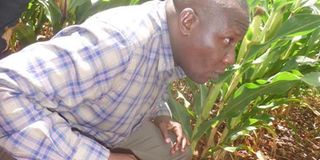Lessons for Ugandan farmers to learn from Brazilian system

One of the legislators from Uganda observing no till technology at Embrapa and the forest livestock integrated farm
Farming practice in Uganda by small scale farmers which include use of hoe for digging is similar to a technology now being used in Brazil and other countries such as USA and Argentina with no tillage of the soil
The technology termed as no till technology is aimed at conservation of the soil nutrients for increased yields
No-till farming system which is practiced by a number of farmers in Brazil offers a way of optimizing productivity and ecosystem services including soil conservation.
At the same time the technology is enabling agriculture to respond to some of the global challenges associated with climate change which include land and environmental degradation.
Dr Lineu Neiva Rodrigues from the Centre of Agriculture and livestock Research (Embrapa) explaining a number of farm practices to a team of legislators from Ugandan Parliament led by the Minister of Science, Technology and Innovations Dr Elyoda Tumwesigye noted that the no-till technology involves farm practices of cutting off grass and covering farm using organic soil cover.
The legislators went on fact finding mission curtsey of Open Forum on Agricultural Biotechnology (OFAB) to understand how Brazil has been able to embrace farm production developed using modern biotechnology and to understand the legal framework governing release of such farm products.
The no till technology where the farm is covered with organic matter is for purposes of avoiding sunlight from penetrating through to the farmland that may cause weeds to grow.
Scientists at Embrampa developed a package of this technology where after grass is cut from the farm, it is left to rot into organic matter for a period of about one month and thereafter the farmer uses a planter to dig holes to plant the seeds.
It is practiced by large scale farmers growing soybean, corn and bush beans and after harvesting the land is irrigated for replanting.
Sometimes farmers use selective herbicide which clears the weed minus destroying the crops.
Dr Nieva says the advantage of this technology is that the soil is conserved and it retains nutrients which enables farmers to harvest increased yields.
Other technologies practiced by farmers in Brazil included the integrated farm practice where farmers own forest farms which are integrated with cattle keeping and forage for the animals to feed. Other farmers prefer integrating forestry trees with crops.
In Brazil farm land used for integrated agriculture of livestock and forestry system and forestry cropping system is about 9 million hectares.
This system allows cattle to gain weight by 600 – 900 grams per day because there is plenty of pasture in the forest cover for animals.
Most farmers practicing this technology grow Eucalyptus and many farmers who have adopted this technology do it on 5 hectares of land or more.
It is advantageous in that farmers are able to keep cash flow all the time and it helps in improving soil fertility and more productivity.
Since the soil fertility in Brazil especially in the Cerado region in Brazilia is so poor, scientists here recommended farmers to ensure they use fertilizer to boost the soil fertility. There was also a deliberate government intervention of reclaiming the land by using chemicals such as lime to boost the entire soil fertility in the region and this has enabled farmers growing corn and soy bean to increase on their productivity.
The Director of Embrampa Dr Ladisladous Martin Neto explained that before 1970’s Brazil was not food secure not until new technologies were developed by scientists including the use of modern biotechnology that led to boosting agricultural production in the country.
The country is now known as one of the largest producers of soybean and corn in the world.
This is possible because the scientists are breeding varieties which are resistant to pests and diseases, drought resistant and varieties that are fixing nitrogen to the soil especially soybean including breeding high quality animals.
The statistics indicates that about 214.8 million tons of grains, 43.8m tons of fruit, 26.8m tons of meat and 35m litres of milk were produced last year.
Since the country wanted to increase its food production, in the year 1995 it had to make sure that there was a biosafety law put in place to regulate adoption of GM crops.
Now the scientists are looking at addressing challenges of water for agriculture apart from embracing technologies like use of nano technology and use of synthetic biology.
Farmers in Brazil are growing GM soybean and corn and other technologies include the GM mosquito used to eradicate the Zika Virus.
There are a number of products under research and they include GM sugar, eucalyptus, rice and citrus which are awaiting release to farmers.
Dr Tumewsigye, commended the good work done by the scientists in Brazil and pledged the two countries to collaborate in issues related to science and technology.
To him it important to learn from scientists and other stakeholders involved in scientific innovations in Brazil and transform this knowledge for Uganda to move to a bio economy.
The Chairperson on the committee of Science and Technology Engineer Kafeero Sekitoleko explained that already the no till technology is being practiced in Uganda through minimum tillage using the hoe but there is a challenge of application of selective herbicides to clear weed because Uganda lacks this type of herbicide for farmer use.
To him it is possible for farmers to embrace the integrated forestry and livestock and crop farm practice but it requires a large peace land therefore adopting technologies developed using Biotechnology would lead to increased yields in farm fields in Uganda.
[email protected]




